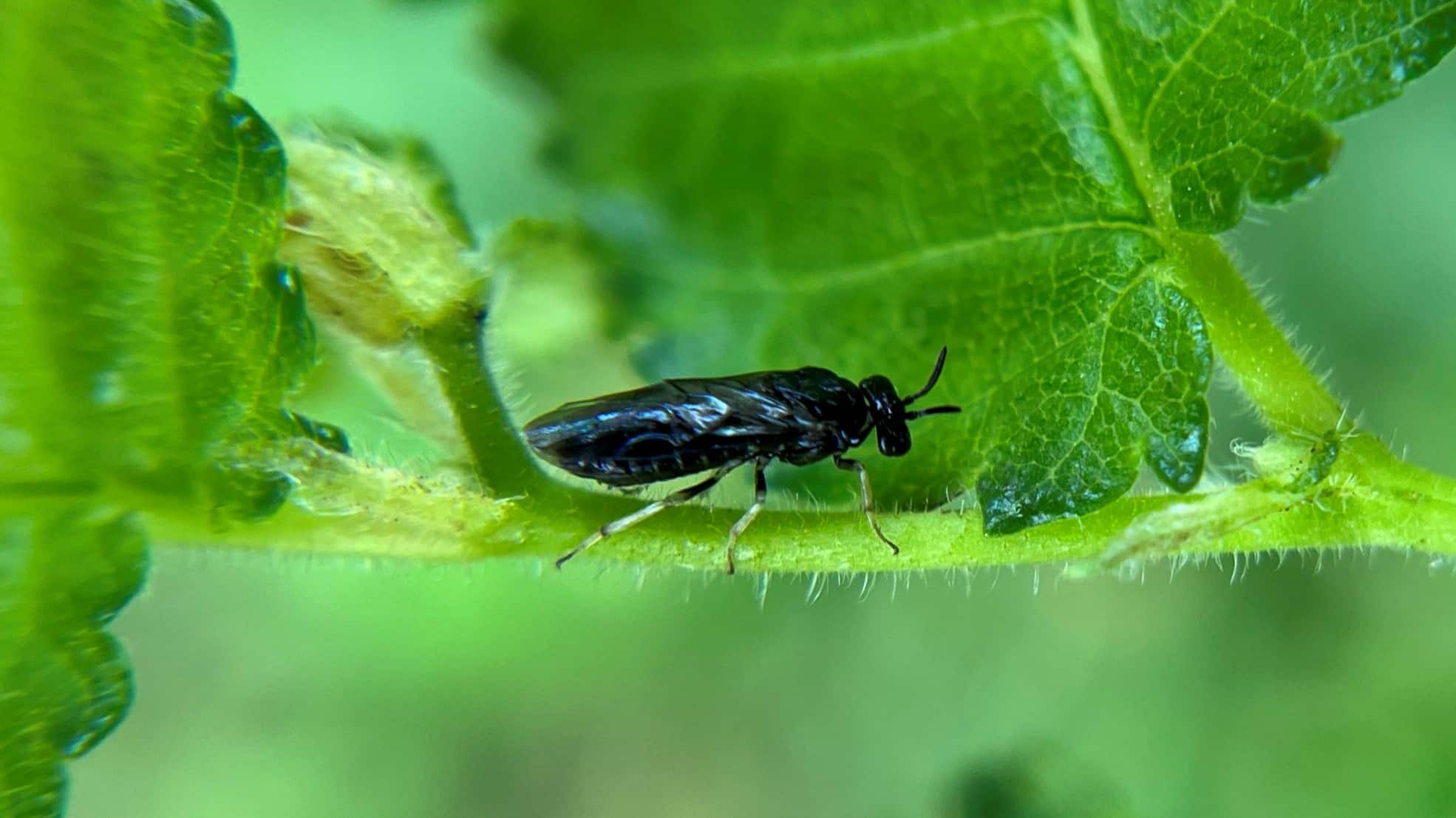A new invasive insect, the elm zigzag sawfly, has arrived in North Carolina. This sawfly, Aproceros leucopoda, is native to East Asia, was first seen in the U.S. in 2021, and it has been detected in five eastern states so far. The insect feeds on the leaves of elm trees, but long-term impacts on tree health and the best ways to manage the insect’s spread are still unknown, according to a North Carolina State University forest health researcher.
The elm zigzag sawfly was identified in North Carolina last year, according to a new paper tracking the insect’s spread.
“This is a very new invasive species first found in Canada in 2020 and in the U.S. in Virginia in 2021,” said the study’s first author Kelly Oten, assistant professor of forest health at NC State. “In 2022, four additional states confirmed it. It happened very quickly. This paper was our effort to document the very first stages of the invasion, and let people know where it is, and what we know about its biology and management so far.”
The Abstract spoke to Oten about the spread of the elm zigzag sawfly, and what researchers know about it.
The Abstract: How quickly has elm zigzag sawfly spread?
Kelly Oten: We aren’t sure how quickly it’s spreading, but we are detecting it in a lot of places in a short period of time. It’s been detected from New York to North Carolina, but we only have it in one spot in N.C. so far. I am working with the U.S. Forest Service to get a lot of states involved in surveying, as we suspect it is in a lot more places that we don’t know about.
TA: How did it get here?
Oten: A lot of invasive species are hitchhikers. Someone could have moved live elm trees with the sawfly on them or its cocoon could have attached to an inanimate object that was moved overseas.
TA: When was it discovered in N.C.?
Oten: Last August, a homeowner in North Carolina called the N.C. Forest Service because their large, mature American elm trees were severely defoliated. After they investigated, I also got called in. We found thousands of sawflies, and trees nearly completely defoliated. All of the badly defoliated trees leafed out well this spring, but they’re getting attacked again. Usually defoliation doesn’t harm a tree unless it happens over and over again. If they are getting defoliated year after year, we have to consider the impact on the trees’ health.
TA: What do you know about the threat of the insect to elm trees?
Oten: We have 210 million elm trees in North Carolina forests, and this does not include urban trees. Historically, elm trees were a very prized street tree. However, an invasive disease, Dutch elm disease, came through and decimated the vast majority of our elms in the mid-1900s. Ironically, a lot of towns and municipalities replaced them with ash trees, and then we saw the same thing happen with the emerald ash borer invasion.
It’s too early to tell right now how damaging elm zigzag sawfly will be to elms. The majority of trees have very minor defoliation. You probably wouldn’t even know something was happening to the tree until you got up close. However, we have seen severely defoliated trees, too, and if this happens year after year, it might stress or weaken a tree or potentially cause dieback and even death. We just don’t have enough information yet.
TA: Is there any way to manage the insect?
Oten: Right now, we are doing research looking at the life cycle of elm zigzag sawfly in North Carolina so we know when to monitor, and when to time treatments. We also have an insecticide trial in place. We don’t think that is a suitable strategy for forest settings, but we’re studying it to see if individual homeowners could use it to protect landscape elm trees from defoliation.
We also received funding to look at natural enemies of the elm zigzag sawfly. We’re already seeing some insects that could be helping to control elm zigzag sawfly like ladybugs and assassin bugs.
TA: What should the public know and do about this?
Oten: Our recommendation for the public right now is to not freak out. We don’t think this is going to be a tree killer, so people don’t need to start cutting down their elms. We do ask that if people see the defoliation pattern on elm trees, to call it into their county extension agent or the N.C. Forest Service. It’s pretty easy to recognize. The insect got its name because it makes a very characteristic zigzag pattern in the leaves as it feeds.

TA: How many more new invasive insects do you expect to see?
Oten: We detected two new invasive species last year. Before that, we went nine years in North Carolina without a new one since the emerald ash borer was detected in 2013. Invasive species aren’t going to go away; they’re a byproduct of global commerce and travel. It’s also a lesson to make sure we diversify our plantings – whether that be in reforestation efforts or in urban plantings – so we don’t have a canopy that’s predominately one tree type, and we don’t lose everything if a new invasive is introduced that attacks it. Hopefully, we will get better at predicting and detecting new non-native species, and improving sanitation methods when we ship things. All of these can help us reduce introductions and damage from invasive species.



